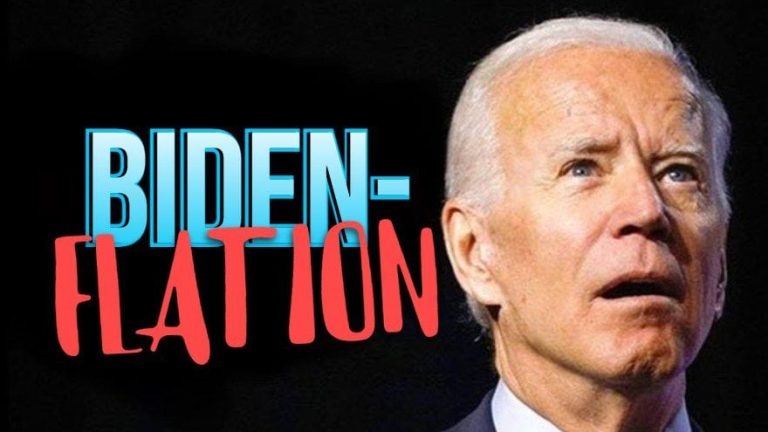The Washington Post recently published an article titled “Economy improves under Biden.” “But many voters don’t give him credit.” The Post credited six writers for the story line. Six writers write an article that assumes the economy is in great shape, but voters are so stupid they don't realize how good things are?
This is what happens when people whose entire world revolves around dinner parties thrown by the Washington elite try to understand working-class Americans.
An examination of the data below the headlines shows that Americans continue to suffer under the US economy and Biden's “Baenomics” economy.
In December 2023, the inflation rate was 3.4%, as measured by the Consumer Price Index. Television pundits and government spokesmen celebrated, noting that in December 2022, the inflation rate was 6.4%, so inflation was under control.
This is a flawed argument that only holds up in the bubble of Washington, DC. Inflation is not decreasing. The rate of increase is slowing down.
Bureaucrats in Washington make the same false argument when they discuss budget cuts, citing lower spending growth as lower costs, which they do not.
The fact is that compared to December 2021, inflation has risen by almost 10%. Although the inflation growth rate has declined significantly since the peak of 9.1% in June 2022, compared to January 2021, prices have risen by more than 17.5%.
When one examines the “basket of needs,” those expenses a household must incur in order to live: food, shelter, and energy, inflation is not only bad, it is devastating.
This is especially true for low-income Americans for whom these expenses represent a larger percentage of income than for those who are more financially secure.
According to Fox Business, since the start of 2021, food prices are up 33.7%, shelter costs are up 18.7%, and energy prices are up a staggering 32.8%.
To put this into perspective, the typical American household would have to spend “an additional $11,434” per year just to maintain the same standard of living it enjoyed in January 2021.
These inflation numbers are more than just statistics. The impact on working Americans is catastrophic.
The Federal Reserve Bank of New York reported that total household debt reached a record $17.29 trillion, while credit card debt also reached record levels, exceeding $1.2 trillion.
Unfortunately, working Americans don't go into debt to buy new TVs and for vacations, they go into debt to buy food and pay utility bills, while incurring 25% interest at the same time.
As their debt levels rise, working Americans struggle to stay on top of their bills.
According to the Philadelphia Federal Reserve, approximately 10% of credit card borrowers owe more than $5,000. Between July 1 and September 30, 2023, nearly 30% of Americans in the 100 largest metro areas were “at least 30 days behind on at least one debt,” which includes credit cards, auto loans, personal loans, mortgages, and student loans. .
Forty percent of the 22 million Americans who had to start repaying student loans in October of 2023 have yet to make their first payment.
Other microeconomic factors also indicate trouble for the US economy.
Nearly 45,000 home purchase agreements were executed in November 2023, nearly 17% of the homes that went into contract that month, the highest percentage in the history of Redfin's home sales survey.
Even economic data that looks like good news at the macro level indicates a problem at the micro level.
The December jobs report showed that employers added 216,000 jobs, exceeding expectations, and the unemployment rate held steady at 3.7%. But the lion's share of the growth came from the growing federal government, which added 52,000 jobs (don't we want government to shrink, not grow), and from low-wage jobs in the health care industry.
The labor force participation rate fell to 62.5%, with more than 680,000 people leaving the labor force.
So, while people isolated in the Washington, D.C., bubble feel no pain, working Americans suffer, and they blame the president.
According to an ABC/Ipsos poll, only 33% of Americans approve of the job President Biden is doing, a decline from his previous low of 37%. The president's disapproval rate is 58%.
His performance is worse with regard to the economy, as 43% of Americans said that they are not in a good situation since Biden took office.
The president will have to steer clear of Biden's economics if he hopes to revitalize his reelection hopes.
Unfortunately for him, he can point out little that might interest voters. Polls on the border are worse than on the economy. The world is experiencing two major wars, and American ships are now under attack in the Red Sea.
This may explain why Biden recently gave a speech in Valley Forge, where he focused not on the economy and Biden's economics, but on former President Trump and Biden's belief that Trump is a threat to democracy.
Unfortunately for the president, the infamous words of Clinton adviser James Carville still ring true: “It's the economy, stupid.”
Jim Nellis is a supply chain consultant based in Chicago, Illinois. He has served as Chief Procurement Officer, Chief Supply Chain Officer, and Chief Operating Officer at several companies. Jim served his country as a Naval Officer after attending college on an NROTC scholarship. He holds a bachelor's degree from Northwestern University in economics and French, as well as a master's degree in management from the J.L. Kellogg Graduate School of Business.

